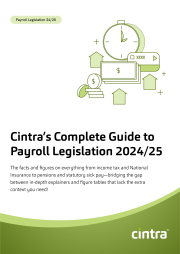Nobody likes paying taxes. We know that they fund a lot of things we need—infrastructure, for example—and some things we hold dear, like the NHS and education, but it’s instinctive to begrudge the payments just a little when they seep out of our pay packet.
National Insurance (NI) is a funny one though. Maybe because it’s called a ‘contribution’, or maybe because we see its value on a more personal level, it doesn’t have quite the same negative press. Perhaps it’s because this is you saving money for future-you and building up your state pension. But it is another form of tax and nearly everyone working in the United Kingdom has to pay it. If you don’t contribute to it, you limit your access to certain benefits and the state pension… so you definitely have to be in it to win it!
So, let’s cover the vital elements of National Insurance Contributions (NICs) that you need to know as a payroll professional.
What is National Insurance?
National Insurance is a form of social security tax. It’s paid by most workers and employers in the UK. And it’s basically your rainy day fund—it’ll turn into a state pension and benefits if they’re ever needed.
It’s mandatory for anyone 16 or over and:
- An employee earning above £242 a week
or
- Self-employed and making over £12,570 a year profit.
How much your employees pay is worked out in a similar way to income tax—it’s calculated on gross earnings (before tax or pension deductions) or profits (earnings minus allowable expenses) above a threshold.
What does National Insurance pay for?
All the funds collected are used to provide state benefits such as the State Pension, Jobseeker’s Allowance, maternity and paternity allowance and others. It’s also used to top up funding for the NHS. It basically does a lot of good for the country, but it also does a lot of good for you in the times you need it most.
Who’s exempt from National Insurance?
- An employee earning between £123 and £242 a week
or
- Self-employed and your profits are between £6,725 and £12,570 a year.
If there are years when your employees fall into these non-paying brackets, contributions are still treated as having been paid to protect their NI record. Which is pretty nice really. And it’s also very important – you need a complete record to qualify for a full state pension or the benefits you may need.
What happens if there are gaps in your National Insurance record?
There may be some periods when people get a gap in your National Insurance record. And that’s not a scenario you’ll want to see. That could be because of a number of different factors. Maybe:
- Living or working outside of the UK
- Self-employed and profits were too low
- Employed but had low earnings
- Enemployed but not claiming benefits.
If you can afford to, and if you’re eligible, try to top up your record and pay some voluntary contributions to fill any gaps because you don’t want this to threaten your access to benefits or your pension. And be aware that there’s a 6 year limit on back-filling those gaps.
How long do I pay NI for?
At state pension age it’s time to stop paying into your NI pot and start drawing from it.
All you need to do is get proof of age from your employees to stop their contributions. If they wish to continue contributing, that’s fine too.
What are National Insurance classes?
The amount of NI paid varies depending on the employee’s particular National Insurance category tax status. There are four (and a bit!) classes of National Insurance.
i. Class 1 is paid by employees when they earn more than £242 a week and are under State Pension age. Their employer will also pay Class 1 on earnings over £175 per week.
ii. Class 1A or 1B. This is the ‘and a bit’ part! Class 1A or 1B is paid on employees’ expenses or benefits.
iii. Class 2 was previously paid by self-employed people earning profits of more than £12,570 a year. From 6 April 2024, self-employed people with profits above £12,570 will no longer be required to pay Class 2 NICs. While not abolished entirely, the contributions are no longer mandatory, and all eligible workers can continue to make voluntary contributions.
iv. Class 3 is what people pay when to fill gaps, as we mentioned above. It’s a voluntary top-up to make sure your NI record is in perfect shape.
v. Class 4 is paid by self-employed people earning profits of £12,570 or more a year Class 4 contributions are charged at 9% on profits between £12,570 and £50,270, then at 2% on profits over £50,270.
What are category letters all about?
Every employee will be assigned an NI category letter based on their circumstances, and that letter can change over time.
And each letter means something different. Let’s crack that code:
| Category letter | Employee group |
|---|---|
| A | Pretty much everyone falls into this category! All employees apart from those in groups B, C, H, J, M, V and Z in this table |
| B | B is for married women and widows entitled to pay reduced NI |
| C | Employees over the State Pension age fall in this one |
| H | Apprentices under 25 will meet different criteria for NICs |
| J | Employees who can defer NI because they’re already paying it in another job |
| M | Employees under 21 – again, different rules apply |
| V | Employees who are working in their first job since leaving the armed forces (veterans) will pay at different rates |
| Z | Employees under 21 who can defer NI because they’re already paying it in another job – basically J+M! |
Then there’s more category letters for employees who work in freeports (freeports might more commonly be known as tax havens – places like the Isle of Man).
| Category letter | Employee group |
|---|---|
| F | All employees who work in freeports, (apart from people who fall into codes I, L, and S!) |
| I | Married women and widows who work in freeports and are entitled to pay reduced NI get their very own NI letter category |
| L | Employees who work in freeports and can defer NI because they’re already paying it in another job are another one to watch out for |
| S | Employees who work in freeports and are over the State Pension age. |
There’s also category letter X. This one is for employees who don’t have to pay NI, for example because they’re under 16. And don’t even get us started on foreign-going mariners and deep-sea fishermen (or women!) because they have a whole different NI plan.
National Insurance thresholds
Alongside the category letters, employers and employees pay Class 1 National Insurance depending on how much the employees earns. Here’s the thresholds for each category in 2024/25:
| Thresholds | Weekly | Monthly | Annual |
|---|---|---|---|
| Lower Earnings Limit (LEL) | £123 | £533 | £6,396 |
| Primary Threshold (PT) | £242 | £1,048 | £12,570 |
| Secondary Threshold (ST) | £175 | £758 | £9,100 |
| Upper Secondary Threshold, Under 21 (UST) | £967 | £4,189 | £50,270 |
| Upper Earnings Limit (UEL) | £967 | £4,189 | £50,270 |
| Apprentice Upper Secondary Threshold (AUST) | £967 | £4,189 | £50,270 |
| Veterans Upper Secondary Threshold (VUST) | £967 | £4,189 | £50,270 |
| Freeport Upper Secondary Threshold (FUST) | £481 | £2,083 | £25,000 |
| Investment Zone Upper Secondary Threshold (IVUST) (new!) | £481 | £2,083 | £25,000 |
Get the latest insights and best practice guides, direct to your inbox.
Categories and NI contributions
When deducting National Insurance from your employees’ pay via PAYE, you’ll do so in-line with each of the below rates that are assigned to each of the categories and thresholds. These are known as primary contributions, and the rates for 2024/25 are:
| Category letter | £123 to £242 (£533 to £1,048 a month) | £242.01 to £967 (£1,048.01 to £4,189 a month) | Over £967 a week (£4,189 a month) |
|---|---|---|---|
| A | 0% | 8% | 2% |
| B | 0% | 1.85% | 2% |
| C | N/A | N/A | N/A |
| F | 0% | 8% | 2% |
| H | 0% | 8% | 2% |
| I | 0% | 1.85% | 2% |
| J | 0% | 2% | 2% |
| L | 0% | 2% | 2% |
| M | 0% | 8% | 2% |
| S | N/A | N/A | N/A |
| V | 0% | 8% | 2% |
| Z | 0% | 2% | 2% |
And it should work something like this…
If you’re a category A person who earns £1,000 in a week you can expect to pay:
- Nothing on the first £242
- 8% on earnings between £242.01 and £967
- 2% on the remaining earnings above £967
What about employer contributions?
Secondary contributions are what your business, as the employer, must pay to HMRC as part of your PAYE bill. Again, you’ll pay a certain amount for each employee depending on each of their earnings and NI category. The rates for 2024/25 are:
| Category letter | £123 to £175 (£533 to £758 a month) | £175.01 to £481 (£758.01 to £2,083 a month) | £481.01 to £967 (£2,083.01 to £4,189 a month) | Over £967 a week (£4,189 a month) |
|---|---|---|---|---|
| A | 0% | 13.8% | 13.8% | 13.8% |
| B | 0% | 13.8% | 13.8% | 13.8% |
| C | 0% | 13.8% | 13.8% | 13.8% |
| F | 0% | 0% | 13.8% | 13.8% |
| H | 0% | 0% | 0% | 13.8% |
| I | 0% | 0% | 13.8% | 13.8% |
| J | 0% | 13.8% | 13.8% | 13.8% |
| L | 0% | 0% | 13.8% | 13.8% |
| M | 0% | 0% | 0% | 13.8% |
| S | 0% | 0% | 13.8% | 13.8% |
| V | 0% | 0% | 0% | 13.8% |
| Z | 0% | 0% | 0% | 13.8% |
Need a bit more advice?
We know. It’s a lot. Especially if you’re the person in charge of working it all out. Payroll isn’t simple at the best of times. But it can be.
Here at Cintra we’ve put in the time and effort to create a highly evolved, compliant and connected suite of software and services that means you don’t have to do all of your payroll alone. Whether you want the payroll software to do the hard work for you, or a fully managed payroll service, where our CIPP-qualified experts become a true extension of your team, we’ll find you a solution where you’re running even the most complex payrolls with speed, accuracy and compliance.
Just book in a demo to find out how we can take the NI-ghtmare out of NI!

Payroll Legislation Guide
The facts, figures, thresholds and allowances for 2024/25 spanning tax, National Insurance, pensions, statutory payments and more.
Download now


